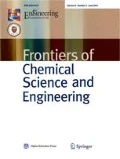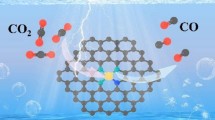Abstract
The catalytic hydrogenation of nitroaromatics is an environmentally friendly technology for aniline production, and it is crucial to develop noble-metal-free catalysts that can achieve chemoselective hydrogenation of nitroaromatics under mild reaction conditions. In this work, zinc-modified Ni-Ti catalysts (NixZnyTi1) were fabricated and applied for the hydrogenation of nitroaromatics hydrogenation. It was found that the introduction of zinc effectively increases the surface Ni density, enhances the electronic effect, and improves the interaction between Ni and TiO2, resulting in smaller Ni particle size, more oxygen vacancies, higher dispersion and greater concentration of Ni on the catalyst surface. Furthermore, the electron-rich Niδ− obtained by electron transfer from Zn and Ti to Ni effectively adsorbs and dissociates hydrogen. The results reveal that NixZnyTi1 (Ni0.5Zn0.5Ti1) shows excellent catalytic performance under mild conditions (70 °C and 6 bar). These findings provide a rational strategy for the development of highly active non-noble-metal hydrogenation catalysts.

Similar content being viewed by others
References
Formenti D, Ferretti F, Scharnagl F K, Beller M. Reduction of nitro compounds using 3d-non-noble metal catalysts. Chemical Reviews, 2019, 119(4): 2611–2680
Xiong W, Wang Z, He S, Hao F, Yang Y, Lv Y, Zhang W, Liu P, Luo H. Nitrogen-doped carbon nanotubes as a highly active metal-free catalyst for nitrobenzene hydrogenation. Applied Catalysis B: Environmental, 2019, 260: 118105–118114
Xiong W, Wang K, Liu X, Hao F, Xiao H, Liu P, Luo H. 1,5-Dinitronaphthalene hydrogenation to 1,5-diaminonaphthalene over carbon nanotube supported non-noble metal catalysts under mild conditions. Applied Catalysis A, General, 2016, 514: 126–134
Huang L, Lv Y, Wu S, Liu P, Xiong W, Hao F, Luo H. Activated carbon supported bimetallic catalysts with combined catalytic effects for aromatic nitro compounds hydrogenation under mild conditions. Applied Catalysis A, General, 2019, 577: 76–85
Amali A J, Rana R K. Trapping Pd (0) in nanoparticle-assembled microcapsules: an efficient and reusable catalyst. Chemical Communications, 2008, (35): 4165–4167
Visentin F, Puxty G, Kut O M, Hungerbühler K. Study of the hydrogenation of selected nitro compounds by simultaneous measurements of calorimetric, FT-IR, and gas-uptake signals. Industrial & Engineering Chemistry Research, 2006, 45(13): 4544–4553
Corma A, Concepcion P, Serna P. A different reaction pathway for the reduction of aromatic nitro compounds on gold catalysts. Angewandte Chemie International Edition, 2007, 46(38): 7266–7269
Peng Z, Li W, Miao Y, Chen S, Liu G, Liu S, Gao J, Li B, Liu Z. Ru nanospheres in water drops for enhanced catalytic performances in selective hydrogenation. ACS Applied Energy Materials, 2018, 1(8): 4277–4284
Jagadeesh R V, Stemmler T, Surkus A, Junge H, Junge K, Beller M. Hydrogenation using iron oxide-based nanocatalysts for the synthesis of amines. Nature Protocols, 2015, 10(4): 548–557
Wei Z, Wang J, Mao S, Su D, Jin H, Wang Y, Xu F, Li H, Wang Y. In situ-generated Co0-Co3O4/N-doped carbon nanotubes hybrids as efficient and chemoselective catalysts for hydrogenation of nitroarenes. ACS Catalysis, 2015, 5(8): 4783–4789
Liu Y, Huang C, Chen Y. Hydrogenation of p-chloronitrobenzene on Ni-B nanometal catalysts. Journal of Nanoparticle Research, 2006, 8(2): 223–234
Ye T N, Lu Y, Li J, Nakao T, Yang H, Tada T, Kitano M, Hosono H. Copper-based intermetallic electride catalyst for chemoselective hydrogenation reactions. Journal of the American Chemical Society, 2017, 139(47): 17089–17097
Tauster S. Strong metal-support interactions. Accounts of Chemical Research, 1987, 20(11): 389–394
Tauster S, Fung S, Garten R L. Strong metal-support interactions. Group 8 noble metals supported on titanium dioxide. Journal of the American Chemical Society, 1978, 100(1): 170–175
Yu K, Lou L L, Liu S, Zhou W. Asymmetric oxygen vacancies: the intrinsic redox active sites in metal oxide catalysts. Advancement of Science, 2019, 7(2): 1901970
Tang H, Liu F, Wei J, Qiao B, Zhao K, Su Y, Jin C, Li L, Liu J J, Wang J, et al. Ultrastable hydroxyapatite/titanium-dioxide-supported gold nanocatalyst with strong metal-support interaction for carbon monoxide oxidation. Angewandte Chemie International Edition, 2016, 55(36): 10606–10611
Li J, Guan Q, Wu H, Liu W, Lin Y, Sun Z, Ye X, Zheng X, Pan H, Zhu J, et al. Highly active and stable metal single-atom catalysts achieved by strong electronic metal-support interactions. Journal of the American Chemical Society, 2019, 141(37): 14515–14519
Zhang S, Xia Z, Ni T, Zhang Z, Ma Y, Qu Y. Strong electronic metal-support interaction of Pt/CeO2 enables efficient and selective hydrogenation of quinolines at room temperature. Journal of Catalysis, 2018, 359: 101–111
Rodriguez J A, Liu P, Wang X, Wen W, Hanson J, Hrbek J, Pérez M, Evans J. Water-gas shift activity of Cu surfaces and Cu nanoparticles supported on metal oxides. Catalysis Today, 2009, 143(1–2): 45–50
Gao T, Chen J, Fang W, Cao Q, Su W, Dumeignil F. Ru/MnxCe1Oy catalysts with enhanced oxygen mobility and strong metal-support interaction: exceptional performances in 5-hydroxymethylfurfural base-free aerobic oxidation. Journal of Catalysis, 2018, 368: 53–68
Xiong J, Chen J, Zhang J. Liquid-phase hydrogenation of o-chloronitrobenzene over supported nickel catalysts. Catalysis Communications, 2007, 8(3): 345–350
Armbruster M, Kovnir K, Friedrich M, Teschner D, Wowsnick G, Hahne M, Gille P, Szentmiklosi L, Feuerbacher M, Heggen M, et al. Al13Fe4 as a low-cost alternative for palladium in heterogeneous hydrogenation. Nature Materials, 2012, 11(8): 690–693
Yu J, Yang Y, Chen L, Li Z, Liu W, Xu E, Zhang Y, Hong S, Zhang X, Wei M. NiBi intermetallic compounds catalyst toward selective hydrogenation of unsaturated aldehydes. Applied Catalysis B: Environmental, 2020, 277: 119273–119281
Wong F H, Tiong T J, Leong L K, Lin K, Yap Y H. Effects of ZnO on characteristics and selectivity of coprecipitated Ni/ZnO/Al2O3 catalysts for partial hydrogenation of sunflower oil. Industrial & Engineering Chemistry Research, 2018, 57(9): 3163–3174
Yarulin A, Berguerand C, Yuranov I, Cárdenas L F, Prokopyeva I, Kiwi M L. Pt-Zn nanoparticles supported on porous polymeric matrix for selective 3-nitrostyrene hydrogenation. Journal of Catalysis, 2015, 321: 7–12
Kumar R, Pant K K. Promotional effects of Cu and Zn in hydrotalcite-derived methane tri-reforming catalyst. Applied Surface Science, 2020, 515: 146010
Belskaya O B, Stepanova L N, Gulyaeva T I, Erenburg S B, Trubina S V, Kvashnina K, Nizovskii A I, Kalinkin A V, Zaikovskii V I, Bukhtiyarov V I, et al. Zinc influence on the formation and properties of Pt/Mg(Zn)AlOx catalysts synthesized from layered hydroxides. Journal of Catalysis, 2016, 341: 13–23
Chen M, Li X, Wang Y, Wang C, Liang T, Zhang H, Yang Z, Zhou Z, Wang J. Hydrogen generation by steam reforming of tar model compounds using lanthanum modified Ni/sepiolite catalysts. Energy Conversion and Management, 2019, 184: 315–326
Baamran K S, Tahir M. Ni-embedded TiO2-ZnTiO3 reducible perovskite composite with synergistic effect of metal/support towards enhanced H2 production via phenol steam reforming. Energy Conversion and Management, 2019, 200: 112064–112079
Pan Z, Wang R, Chen J. Deoxygenation of methyl laurate as a model compound on Ni-Zn alloy and intermetallic compound catalysts: geometric and electronic effects of oxophilic Zn. Applied Catalysis B: Environmental, 2018, 224: 88–100
Jansi Rani B, Ravi G, Yuvakkumar R, Ravichandran S, Ameen F, AlNadhary S. Sn doped α-Fe2O3 (Sn = 0, 10, 20, 30 wt-%) photoanodes for photoelectrochemical water splitting applications. Renewable Energy, 2019, 133: 566–574
Miao C, Zhou G, Chen S, Xie H, Zhang X. Synergistic effects between Cu and Ni species in NiCu/γ-Al2O3 catalysts for hydrodeoxygenation of methyl laurate. Renewable Energy, 2020, 153: 1439–1454
Hidalgo J J, Wang Q, Edalati K, Cubero S J M, Razavi K H, Ikoma Y, Gutiérrez F D, Dittel M F A, Rodríguez R J C, Fuji M, et al. Phase transformations, vacancy formation and variations of optical and photocatalytic properties in TiO2-ZnO composites by high-pressure torsion. International Journal of Plasticity, 2020, 124: 170–185
Liu D, Wang C, Yu Y, Zhao B, Wang W, Du Y, Zhang B. Understanding the nature of ammonia treatment to synthesize oxygen vacancy-enriched transition metal oxides. Chem, 2019, 5 (2): 376–389
Yang F, Yang R, Yan L, Liu X, Luo X, Zhang L. In situ growth of porous TiO2 with controllable oxygen vacancies on an atomic scale for highly efficient photocatalytic water splitting. Catalysis Science & Technology, 2020, 10(16): 5659–5665
Kumar C P, Gopal N O, Wang T C, Wong M, Ke S C. EPR investigation of TiO2 nanoparticles with temperature-dependent properties. Journal of Physical Chemistry B, 2006, 110(11): 5223–5229
Wang D, Kang X, Gu Y, Zhang H, Liu J, Wu A, Yan H, Tian C, Fu H. Electronic tuning of Ni by Mo species for highly efficient hydroisomerization of n-alkanes comparable to Pt-based catalysts. ACS Catalysis, 2020, 10(18): 10449–10458
Liang G, He L, Cheng H, Zhang C, Li X, Fujita S, Zhang B, Arai M, Zhao F. ZSM-5-supported multiply-twinned nickel particles: formation, surface properties, and high catalytic performance in hydrolytic hydrogenation of cellulose. Journal of Catalysis, 2015, 325: 79–86
Zhao J, Chen C, Xing C, Jiao Z, Yu M, Mei B, Yang J, Zhang B, Jiang Z, Qin Y. Selectivity regulation in Au-catalyzed nitroaromatic hydrogenation by anchoring single-site metal oxide promoters. ACS Catalysis, 2020, 10(4): 2837–2844
Hussain I, Jalil A A, Hassan N S, Hambali H U, Jusoh N W C. Fabrication and characterization of highly active fibrous silicamordenite (FS@SiO2-MOR) cockscomb shaped catalyst for enhanced CO2 methanation. Chemical Engineering Science, 2020, 228: 115978
Zhang S, Chang C, Huang Z, Li J, Wu Z, Ma Y, Zhang Z, Wang Y, Qu Y. High catalytic activity and chemoselectivity of sub-nanometric Pd clusters on porous nanorods of CeO2 for hydrogenation of nitroarenes. Journal of the American Chemical Society, 2016, 138(8): 2629–2637
Wang L, Guan E, Zhang J, Yang J, Zhu Y, Han Y, Yang M, Cen C, Fu G, Gates B C, Xiao F S. Single-site catalyst promoters accelerate metal-catalyzed nitroarene hydrogenation. Nature Communications, 2018, 9(1): 1–8
Niu H, Lu J, Song J, Pan L, Zhang X, Wang L, Zou J. Iron oxide as a catalyst for nitroarene hydrogenation: important role of oxygen vacancies. Industrial & Engineering Chemistry Research, 2016, 55 (31): 8527–8533
Yang L, Jiang Z, Fan G, Li F. The promotional effect of ZnO addition to supported Ni nanocatalysts from layered double hydroxide precursors on selective hydrogenation of citral. Catalysis Science & Technology, 2014, 4(4): 1123–1131
Zhang L, Zhou M, Wang A, Zhang T. Selective hydrogenation over supported metal catalysts: from nanoparticles to single atoms. Chemical Reviews, 2020, 120(2): 683–733
MacQueen B, Royko M, Crandall B S, Heyden A, Pagán-Torres Y J, Lauterbach J. Kinetics study of the hydrodeoxygenation of xylitol over a ReOx-Pd/CeO2 catalyst. Catalysts, 2021, 11(1): 108–124
Banu I, Bumbac G, Bombos D, Velea S, Gălan A, Bozga G. Glycerol acetylation with acetic acid over Purolite CT-275. Product yields and process kinetics. Renewable Energy, 2020, 148: 548–557
Gao R, Pan L, Wang H, Zhang X, Wang L, Zou J. Ultradispersed nickel phosphide on phosphorus-doped carbon with tailored d-band center for efficient and chemoselective hydrogenation of nitroarenes. ACS Catalysis, 2018, 8(9): 8420–8429
Lin W, Cheng H, Ming J, Yu Y, Zhao F. Deactivation of Ni/TiO2 catalyst in the hydrogenation of nitrobenzene in water and improvement in its stability by coating a layer of hydrophobic carbon. Journal of Catalysis, 2012, 291: 149–154
Millán R, Liu L, Boronat M, Corma A. A new molecular pathway allows the chemoselective reduction of nitroaromatics on non-noble metal catalysts. Journal of Catalysis, 2018, 364: 19–30
Acknowledgements
This work was supported by the National Natural Science Foundation of China (Grant Nos. 22078277 and 21908185), Project of Hunan Provincial Education Department (Grant Nos. 19B572 and 20B547), the Collaborative Innovation Center of New Chemical Technologies for Environmental Benignity and Efficient Resource Utilization, and the National Department of Education Engineering Research Centre for Chemical Process Simulation and Optimization.
Author information
Authors and Affiliations
Corresponding authors
Electronic Supplementary Material
11705_2021_2072_MOESM1_ESM.pdf
Zinc modification of Ni-Ti as efficient NixZnyTi1 catalysts with both geometric and electronic improvements for hydrogenation of nitroaromatics
Rights and permissions
About this article
Cite this article
Liu, P., Liu, Y., Lv, Y. et al. Zinc modification of Ni-Ti as efficient NixZnyTi1 catalysts with both geometric and electronic improvements for hydrogenation of nitroaromatics. Front. Chem. Sci. Eng. 16, 461–474 (2022). https://doi.org/10.1007/s11705-021-2072-8
Received:
Accepted:
Published:
Issue Date:
DOI: https://doi.org/10.1007/s11705-021-2072-8




